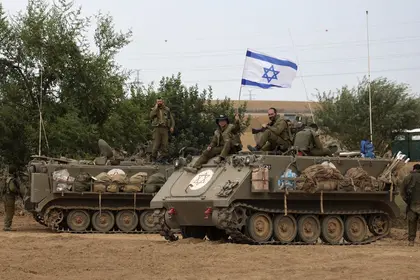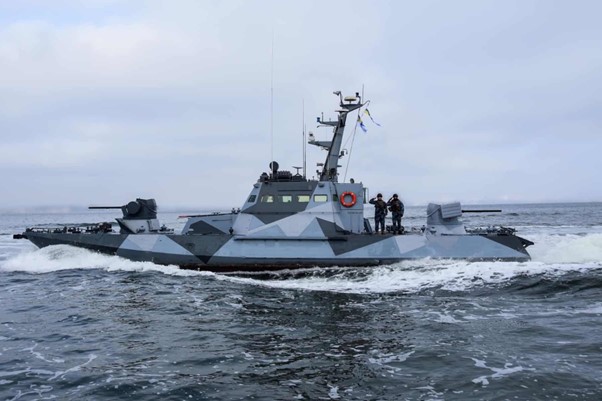Rarely in military history are nations afforded second opportunities to course correct and make the right decision. But 78 years after the conclusion of World War II, the United States and Great Britain have once again found themselves in a position to prevent Russia from threatening Eastern Europe.
Ukrainian President Volodymyr Zelensky and his generals are on the cusp of defeating Russian President Vladimir Putin in Ukraine and putting an end to his Peter the Great-like aspirations of restoring the former Soviet Empire. If Putin loses, the dictator might find himself exiting the stage by leaving through the proverbial open window.
JOIN US ON TELEGRAM
Follow our coverage of the war on the @Kyivpost_official.
If one or both are achieved, the second- and third-order effects would be immediate and positive. It would likely put an end to Moscow’s capacity to foment global instability via its “Arsenals of Evil” partners – including Iran’s probable collaboration with Hamas to plan and launch a multi-domain operation against Israel.
To get there, however, we must rethink the unthinkable. Victory is within grasp – and lessons can be learned from a similar window of opportunity that presented itself in 1945.
By the time World War II was nearing an end, Prime Minister Winston Churchill and US Army General George S. Patton had grown to distrust Russian dictator Joseph Stalin and the Soviet Union’s intentions in Europe. Both men accurately foresaw what was to come: Stalin’s Eastern Europe land grab, and argued it was necessary to militarily counter Stalin’s aspirations.

US Suspends Ukraine Refugee Program
Patton wanted to act before the end of the war and urged US General Dwight D. Eisenhower to authorize his Third Army to move on Berlin as a strategic check on Stalin. Churchill, meanwhile, boldly ordered British Brigadier Geoffrey Thompson to plan and develop “Operation Unthinkable.”
Designed as “a massive ground, air and naval offensive against the Soviet Union,” it aimed to drive “deep into Soviet-occupied territories” and put an end to Stalin’s machinations in Eastern Europe. While the theory and notion were on point, the timing and construct were not.
Another window of opportunity – larger than that of 1945 – may be presenting itself.
Slated to begin on July 1, 1945 – 7 weeks after Victory in Europe Day – it was simply a bridge too far and too soon. There were other problems as well. The “Soviets had 170 divisions available that spring, whereas the Americans and British could muster just 47,” and the plan called for “the rearming of both the Wehrmacht and SS.” Finishing the war in Japan was also a complicating factor.
British Field Marshal Sir Alan Brooke and General Hastings Ismay were strongly opposed to the plan, and on June 8, 1945, Churchill’s chiefs of staff formally rejected Operation Unthinkable. Churchill was ousted from office after losing the election on July 26, 1945. Operation Unthinkable was no more, and the plan was relegated to a Top-Secret folder stamped “Russia: Threat to Western Civilization.”
Instead, the Cold War between the West and the Soviet Union began – spanning from 1947 to 1991. East Germany, Königsberg – known today as Kaliningrad, the Baltic States, Poland, Hungary, Czechoslovakia, Romania, Bulgaria, and Albania all fell under the control of the Soviet Union and disappeared behind its “Iron Curtain.”
NATO now finds itself at the same inflection point Churchill and Patton foresaw as an existential fork in the road toward the end of World War II. Confront Russia now or be forced to do it later and likely at a far greater cost.
Recent events in the Sahel, including the coup in Niger, and presently, Hamas’ ongoing military operation against Israel, are an indicator of just how high the price of waiting is likely to be. Things are not going to get better in Putin’s Russia; only worse, far worse.
Putin’s army now, as Stalin’s Red Army was toward the closing months of World War II – is vulnerable. Sensing weakness, Patton wanted to act.
During a May 7, 1945, contentious meeting with US Secretary of War Robert Patterson about impending partial demobilization in Europe, Patton expressed his belief in the need to confront Stalin. Patton was incensed that he had been ordered: “to hold back his army and wait for the Red Army to occupy vast stretches of German, Czech, Rumanian, Hungarian, and Yugoslav territory, which the Americans could have easily taken instead.”
Thinking the unthinkable, Patton saw not only the need but an opportunity to act. Then, as now, the Russian army’s ability to sustain its forces was stretched. Patton told Patterson “Their (the Soviet) supply system is inadequate to maintain them in a serious action such as I could put to them.” To no avail, Patton further implored, “Let’s not give them time to build up their supplies. If we do, then… we have had a victory over the Germans and disarmed them, but we have failed in the liberation of Europe; we have lost the war!”
Many of those conditions exist today for the Russian Army in Ukraine. They are a depleted and demoralized army with 280,000 plus soldiers killed in action. The Kremlin is reliant upon supplies, weapons and ammunition from their “arsenals of evil” – North Korea and Iran.
Russian supply lines are vulnerable to interdiction. S-300/400 air defense systems cannot provide security to airfields, seaports, bridges, or military headquarters in Crimea. The Russian Defense Ministry is forced to rely on mercenaries from PMC Wagner and Chechnyan foreign fighters. Russia’s borders are not secure and rear areas are routinely attacked by anti-Putin forces, Ukrainian Special Forces, and partisans.
Putin’s defensive lines in Donbass and Zaporizhzhia are close to breaking. Russian General Valeri Gerasimov’s military in Ukraine may be rapidly approaching its tipping point, and another window of opportunity – larger than that of 1945 – may be presenting itself to the US and Great Britain to defeat Russia.
I say this to our allies, give Zelensky the tools, the Ukrainians will finish the job.
Yet instead of enabling Ukraine to close out the enemy, Washington elected to pass a 45-day continuing resolution (CR) that provides “disaster relief funds, an extension of a federal flood insurance program and FAA reauthorization — but no Ukraine aid.”
US funding for the Ukraine war has been politicized – with each side blaming the other even though the CR sans Ukraine aid was passed with an overwhelming bi-partisan vote. It passed 335-91 in the House of Representatives and 88-9 in the Senate.
After 20 months of combat and over $46.4 billion in military aid invested in the war, there is a sense of Ukraine war fatigue in the US But to stop funding now, when victory is within grasp, is unconscionable.
The war in Ukraine will continue during the 45-day CR. While the break in funding will not have an immediate impact, it will afford time eventually on the battlefield for Russia to build new defensive positions, seed new minefields, and launch more missiles at civilian targets.
British Prime Minister Rishi Sunak, like Churchill before him, gets it and is taking a different approach. On Oct. 4, he wrote on his X feed, “I say this to our allies, give Zelensky the tools, the Ukrainians will finish the job.” That message was likely oriented to the United States and Germany. Both countries continue to hold out on providing Ukraine with precision deep strike weapons needed to bring this war to a conclusion – specifically ATACMS and the Taurus Cruise Missile.
US President Joe Biden needs to channel his inner Churchill and assemble his own “Operational Unthinkable” strategy group. Mounting civilian massacres are one more reason why. Russia slaughtered 51 civilians on Oct. 5 attending a memorial service near a café and store in the village of Hroza, Kharkiv Region with an Iskander missile. Hamas, two days later, murdered and tortured 260 people attending a music festival in southern Israel.
To accomplish this, Biden must gather the leadership from both parties to jointly develop a plan acting on advice from the Pentagon and national security officials to support Ukraine – and Israel. The two are connected. Putin’s fight is against the West, not just Ukraine and not just against Jerusalem via Tehran. The resulting plan cannot be to just defend Ukraine – but to enable Ukraine to win, to defeat Russia.
This entails creating an end state wherein Ukraine’s territorial integrity is restored to its pre-2014 borders, ironclad security guarantees against any future invasion by Russia, and crucially, an accession path to full NATO membership.
Once crafted and agreed upon, then the President needs to deliver and sell the plan to the American people – and to explain why Putin is likely threatening Israel via Iran and Hamas to get his way in Ukraine. Neither must be allowed to succeed.
Striving for the unthinkable means thinking it necessary for Ukraine to win – and to not let Putin get away with using Hamas’s war against Israel as a distraction. To fully get there, that also means Washington and Brussels must stop buying into Putin’s nuclear bluster and rhetoric, including, most recently, his speech in Sochi on Oct. 5, when he announced Russia had “successfully tested the nuclear-powered, nuclear-capable Burevestnik strategic cruise missile,” and that “Russia could resume nuclear testing for the first time in more than three decades.”
Putin is unlikely to use nuclear weapons in an offensive capacity. He understands the repercussions and values his life more than anyone else’s. His COVID protocols, meal tasters, and hasty departures from Moscow in the face of air attacks and insurrection are evidence enough of just how much he fears for his own life.
Putin’s red lines are falling by the wayside, to include his Crimean red line. Ukraine essentially erased it by making the peninsula increasingly untenable and forcing the Russian Black Sea Fleet to abandon its Sevastopol naval base.
Today it is Ukraine and Israel under attack. But should Ukraine fall, countries once subjected to the tyranny of Soviet oppression may not stand by idly to await their turn. Many are now NATO countries – living under the protection of Article V. They may decide to act decisively where Churchill and Patton could not – and not wait for Putin to reset.
Churchill and Patton warned us that this moment in time was coming. In a telephone call after the end of World War II with Gen. Joseph T. McNarney, Eisenhower’s deputy, Patton exclaimed, “Hell, why do you care what the [expletive] Russians think? We are going to have to fight them sooner or later with the next generation.”
It was not the next generation, but it is ours. Either we come together and rethink the unthinkable so as to ensure Ukraine and Israel win – or the US and NATO may soon be fighting Russia itself.
The views expressed in this opinion article are the author’s and not necessarily those of Kyiv Post.
You can also highlight the text and press Ctrl + Enter










